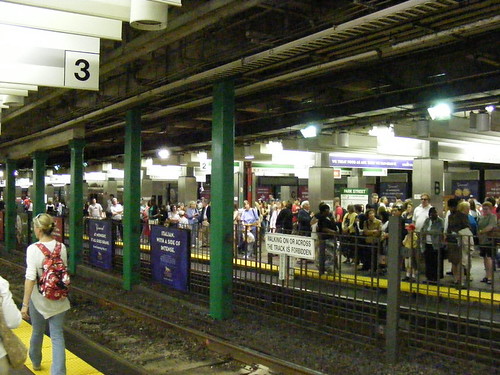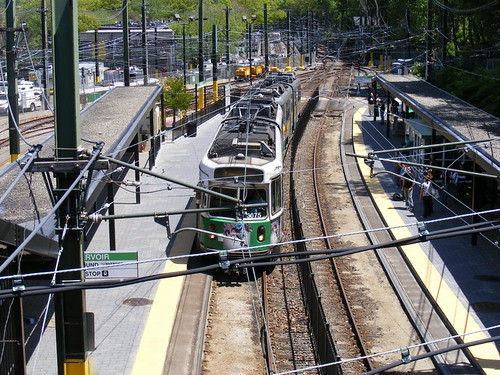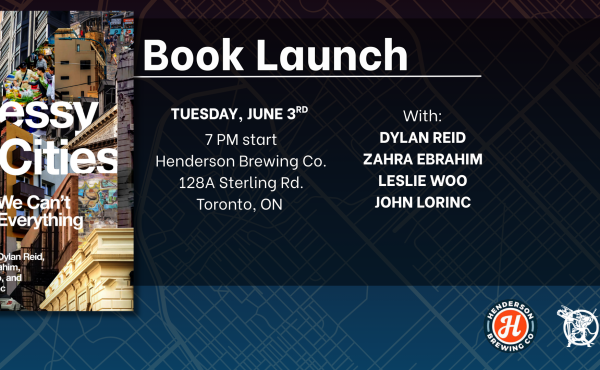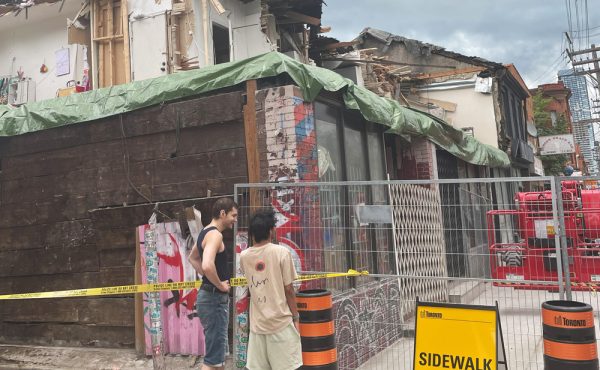A crowded Green Line train at Park Street Station
(Note: Recently, my computer crashed and I had trouble finishing my posts on Spacing Toronto of the road trip I took to New England. There are a few more installments to complete my series.)
During my visit to Boston on Victoria Day weekend, I made a point of riding the famed Massachusetts Bay Transportation Authority, or “T”. I was particularly interested in Boston’s transit system as it has both North America’s oldest subway (actually, a streetcar tunnel through the downtown core) and new bus rapid transit lines.
Like many eastern US cities (such as New York, Philadelphia and Baltimore and the State of New Jersey), all the transit modes over a very large area are operated by a single transit authority. The MBTA operates everything from commuter rail to ferries to subways to paratransit and does a relatively good job at coordinating fares between all modes. The MBTA was also one of the largest adopters of smart card RFID technology, a concept that is slowly coming to Toronto. The smartcard has been named “CharlieCard” – a rather clever name based upon a political campaign tune, later a popular folk song, about a man named Charlie trapped in the subway due to a 1948 implementation of an exit-fare on the Boston rapid transit system.
The introduction of a self-service fare system using smartcards in Boston (and elsewhere, such as Chicago and Washington) has changed the role of fare collectors, which has resulted in a great improvement. Fare collectors have become customer service agents, answering questions, helping customers who have trouble with the machines and also serving an important security purpose that cameras just don’t do. Two years ago in Chicago I saw a station agent come out from her booth to yell at a customer smoking on the open-air platform in the Loop. I am sure such a change would be welcomed by many critics of TTC customer service here.
Click on map to see larger version
Boston has four rail transit lines, all identified by colour: Red, Orange, Blue and Green, each with their own peculiarities. The Blue Line still uses overhead wire for most of its route, the Orange Line was diverted many times during the course of its existence, but still serves the same terminals. Even the nomenclature is interesting as each of the lines’ colours for the four lines were determined by the nature of their routes: The Red Line passes by Harvard University, whose school colour is Crimson; The Blue Line passes under the Harbor, the Orange Line once ran down Orange Avenue (now Washington Avenue), and the Green Line serves the “Green Necklace” of parks on the west end.
Boston is also one of the last transit systems to operate PCC streetcars in regular service; San Francisco and Kenosha, Wisconsin are the other two in North America. However, due to transit construction that weekend, I never had the opportunity to ride the Mattapan “High Speed Line”, a continuation of the Ashmont branch of the Red Line.
The Green Line is a sub-system of four light rail branches: apart from a section of the E-Heath branch, all tracks are separated from regular traffic either by tunnel, elevated section, private right of way, or median reservation. On the outer branches, the concept works well, providing relatively frequent, relatively quick transit to urban neighbourhoods and educational and cultural institutions spread out in the west end. But in the central core, the LRVs (which are much bigger than the small trolleys of 1897 for which the tunnels were designed) have a terrible tendency to bunch and leave large service gaps, even on weekends (I found that crowds to and from Fenway Park exasperated the situation). The D-Riverside branch is different from the other street-running branches as it is entirely in its own right-of-way and seemed to be the more reliable of all the routes.

An underground station on the Green Line
 The high-speed D-Riverside branch at Reservoir Station
The high-speed D-Riverside branch at Reservoir Station
It should be said that the Green Line not a direct comparison with Transit City at all. But the 1897 Tremont Street Subway concept of is the same idea of what is planned for Eglinton and the southern parts of the Jane and Don Mills routes. In the underground segments, passengers pay a fare at the fare gate like at a subway. On the surface, passengers pay the driver at the front of either car of the train. The surface sections of the Green Line allow one to see some of the diverse neighbourhoods of the city (just as one of my favourite ways of seeing Toronto is on the streetcar.)

The wide right-of-way on Beacon Street on the C-Cleveland Circle branch.
One of the other transit curiosities was the Silver Line, a bus “rapid transit” system with two components – the Washington Street Silver Line, a simple Viva-type service with branded buses, fancy shelters and limited stops along the old Orange Line corridor; and the Waterfront component, a much more expensive project tied in with the Big Dig that connects South Station with the harbour, the new convention center and the airport. Buses run on overhead electric power in the bus only tunnel and diesel power outside. I tried out the service to get to Logan Airport (nearby across the harbour) and found that it was an ordeal. Even for “BRT”, buses were bunched and overcrowded, and the speeds in the tunnel unimpressive. There was a long layover at Silver Line Way station, where the trolley poles were dropped and the diesel engine started up. The old way to the airport, via the Blue Line and shuttle bus (there is no direct rail connection), felt like a more efficient route.
 Waiting for a Silver Line bus to Logan Airport at South Station
Waiting for a Silver Line bus to Logan Airport at South Station
Apart from New York, when ever I’ve traveled in North America, I’ve come to appreciate Toronto’s small and underfunded subway. Sure, our subway might be less ancient, rickety and offer great views like Chicago’s L, or have interesting designs, like Montreal, but the knowledge that large, spacious subway trains will never run less than every 5 minutes apart is comforting compared to long waits for needlessly packed trains in places in comparable urban centres such as Chicago, Boston or Washington. Toronto may have less subway, but we run what we have very well.
 A Blue Line train in East Boston, on one of the only overhead powered metro lines in North America (along with Cleveland)
A Blue Line train in East Boston, on one of the only overhead powered metro lines in North America (along with Cleveland)






18 comments
I’ve always had a soft spot for the MBTA, since it is in many ways an alternate-universe version of the TTC. It’s a well-worn but solid system, and very comparable to Toronto’s, or at least what Toronto’s transit system might have been.
– Had the Queen streetcar tunnel been built, most of the city’s East-West streetcar lines would probably now feed into it, running very much like the Green Line. And of course those median right-of-ways are similar but a lot more extensive than the ones found on TTC lines.
– The Red Line is pretty similar to TTC subways (the cars are even made by Bombardier). No express lines like NY or Philly, just tightly-spaced, well-run trains servicing stations that grow more distant in the outer reaches.
– Boston and Toronto were the last of the old fashioned token-booth cities, and had the TTC been a little bit less awful, the CharlieCard setup is what Toronto would be using right now.
– The Silver Line is very much what one would expect to have seen on, say, Eglinton to the airport in an alt-universe Toronto
– Mattapan PCC link is kind of like the Scarborough RT, and probably what the RT would look like had it been built as a streetcar extension.
– The TTC could have easily ended up running GO Trains and Harbour ferries (it once did, at least for the ferries) as the MBTA does.
– The trolley-bus to subway transfers at, say, Harvard, are very similar to TTC in-station transfers. (And of course, Boston kept their trolleybuses)
– Their website is a better version of what the TTC’s new website is trying to be (even the same subway line menu header)
– Finally, riding MBTA makes me think of a mirror universe where the TTC was not the most expensive transit system in North America. Boston’s one way fare of $1.70 and the monthly pass costs FIFTY-NINE DOLLARS. That’s five-nine. $59.00. Argh.
It costs seniors $0.40 to ride the subway in Boston.
Beware the blue line! It always broke down when I was living there, those pesky overhead power lines would disconnect and I’d be stuck with some crazy locals for a tad too long.
They’ve also started installing new gates at each station to replace the old turnstiles – which I hope (and pray) Toronto will avoid. They were made of glass and swooshed open – a cool effect at first, though after a few rides they seemed timely, and every once in a while would squish you between two glass blades of horror.
One other thing I forgot to mention were the giant parking garages at the ends of the Red Line. I parked at Quincy Adams station, to get to it from I-93/Route 128, you could take freeway ramps all the way to the parking booths at the entrance to the garage, much like a large airport terminal. The Alewife Station, on the opposite end, has the same set-up.
The incredibly high fares we have to put up with here are driven home when I visit other metro systems – the Mexico City Metro is 2 pesos, or $0.20, a ride, and last year rode around Los Angeles for a whole day for $3.50. In Boston, I only used the MBTA for 3 days, but found the $15 weekly pass the cheapest option. $15!
Being used to the 5± minute service on the Toronto subway system, it can become worrying when one misses a train on the New York or Atlanta subway as I have. One starts to speculate, is there a problem or incident on the line?
The non-TTC “normal” headway is 10± minutes, less than that becomes “frequent”. But 10± minutes is long enough to walk 1 km, for an average person. So does one wait or walk? Would be nice to have a “Next Westbound Train in 1 and 11 Minutes” at an entrance.
uSkyscraper, somehow I doubt you’d want TTC to operate any more services than it currently does. It’s good to have competition, it’s good to have options. I don’t want one service running everything, because it will inevitably run it terribly.
Integrated fares, separate services.
Sean — nice write-up. I lived car-free in Boston from 1998-2004 and was a big T user — mostly the Red Line.
The Green Line is a strange beast. It looks good on paper and for casual travel, but is a nightmare for commuting — far worse than any Toronto rush-hour subway crush I’ve experienced. I knew a lot of people who deliberately avoided Green Line areas in their apartment and house-hunting, just because of how rough the commute is.
The Blue Line is underused relative to the other lines (I’m pretty sure it wouldn’t meet Toronto’s “density” requirements). There is a new subway station (opened 2004) near Logan Airport that’s quite nice (and a lot easier to use than the monstrosity it replaced). There is a T stop on the Blue Line near Revere Beach. (Yes, Boston’s subway goes both to the airport and to the beach.)
Smart cards (they had not been introduced when I left Boston in 2004) and lower fares (bus-only monthly T pass for under $30) aside, transit service in Boston can be horrendous outside of rush hour. Sunday evenings are the worst — when I lived there, the train headway on the Blue Line was something like 14 minutes, and not a whole lot less on the Red Line. Many inner-suburban bus routes (especially in Cambridge, Somerville and Medford) run only hourly after 7pm. Torontonians would throw their hands up at this kind of service, but no-one in Boston seems to complain.
another Jordan:
It really is surprising to see, but most other cities haven’t anywhere NEAR the frequency of service we do, especially for surface routes.
.. rest of my comment was eaten by the interweb…
” under 10 minute frequency, especially for surface bus routes until midnight, is basically unheard of in other cities.
We’re spoiled rotten, but its something I’m happy to see. :D”
re: The frequent service here
Has anybody noticed that, downtown at least, there’s a culture of utterly refusing to deal with a schedule. Everyone pretty much just shows up at a stop and expects a bus/streetcar to show up within a few minutes. I don’t necessarily see it as a bad thing, since it sets our expectations high.
One important point to note about Boston’s introduction of smart cards is that the system it replaced was horrendously complex with separate fares for subway and surface routes, zone fares, differences between streetcar lines (that were considered as “rapid transit”) and bus lines, not to mention bizarre arrangements of paying more on an inbound trip than an outbound trip to simplify fare collection.
TTC’s flat fare, free transfer system is a breeze by comparison.
One thing I noticed about the parking set-up at Alewife station on a recent trip – a good chunk of the space was devoted to vehicles that had to be out of the garage by 6 or 7 pm (don’t remember the exact time) or else risk being towed.
Steve makes a good point — as of 2003 at least, tokens could be used on the subway but not on the bus, and there were three classes of T-pass (bus only, subway only, and bus plus subway). The first two of these were very cheap — under $40 a month, if I recall. Cash fare for the subway was about $1.25 when I left.
Only the Green Line had a complicated fare structure — a quasi-zone system was in effect on that line on the D-Riverside branch, which stretches much further out into the suburbs. Some lines collected double fares on outbound trains but free travel inbound (or vice versa).
“A Blue Line train in East Boston, on one of the only overhead powered metro lines in North America (along with Cleveland)”
Sweet Home Chicago, did you miss the “Skokie Swift” or do you consider that light rail in your book? ;-p
and “Even for “BRTâ€Â, buses were bunched and overcrowded, and the speeds in the tunnel unimpressive.” … sounds just like OC Transpo
Dan – the Skokie Swift lost the overhead wires back in 2004, so I believe that Boston Blue and Cleveland Red are the only heavy rail metros with overhead electrification. Monterrey and Guadalajara are perhaps the other two exceptions in North America.
As for Boston’s bus service, I totally agree. I picked up a system map and was aghast at the bus frequencies, particularly after 6PM and weekends. I find that only New York, San Francisco (on paper, at least) and some parts of Chicago, Washington, and Los Angeles have bus schedules that aren’t shameful in off-peak periods. I only used a bus once, a relatively frequent route that is a “busitution” for an abandoned portion of the E-Heath streetcar.
Even suburbs like Brampton and Mississauga have service levels that would be the envy of US cities twice their size. The reaction to higher gas prices there does make me wonder if things will change though.
BART in the San Francisco Bay Area runs punctually but infrequently – for an (U.S.) east coast transplant. It’s more like a commuter rail than a subway system. The last place I lived on the east coast was Boston. Go T.
I suspect you meant “exacerbated”, not “exasperated” — though, from living in Boston and points south, I can sort of understand why that word might come to mind when thinking of travel.
Btw now the ttc uses tokens, some cheaper deals in some situations. Also the ttc buses are run by electric moters, not fuel, so i like that becuase its eco freindly. And the intervals of trains is around 2-4 mins now and buses 1-6 mins. But its just a nice service.